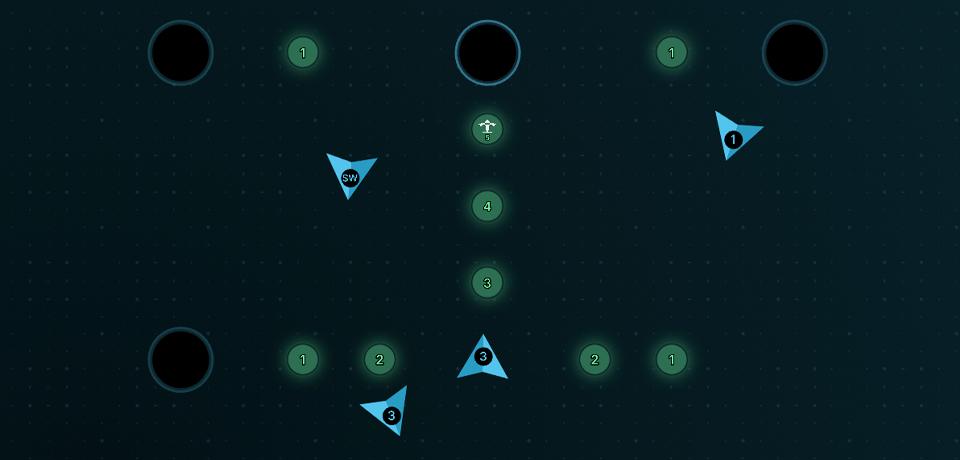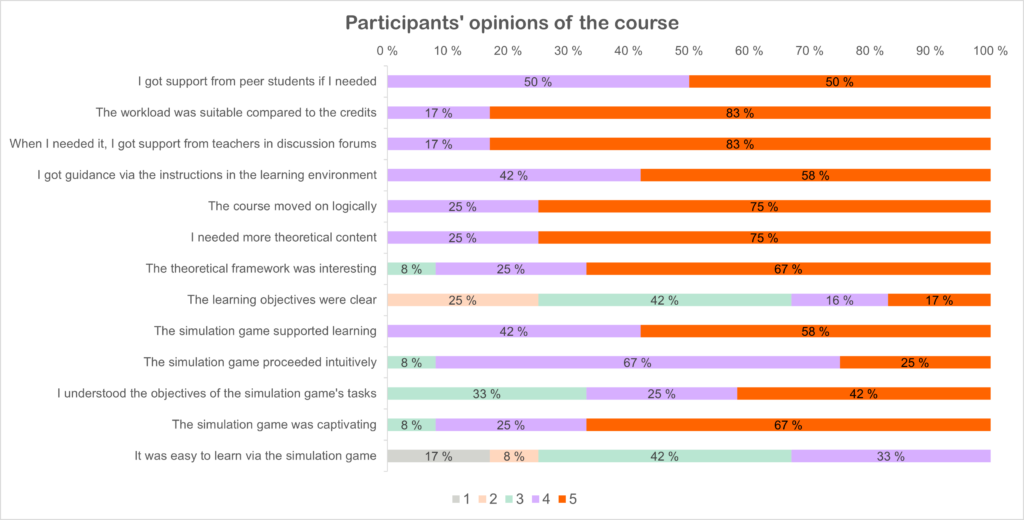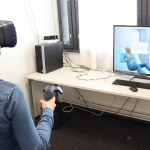
Anne-Maria Korhonen & Samuli Suokas
New environments and methods that reflect our digital era are constantly being sought for learning. Expectations for simulators and simulation games are high since students are increasingly familiar with digital tools and gaming elements. The air traffic control simulator was created to give more opportunities to make it easier to practice air traffic controller’s work tasks. The simulator runs online and offers new opportunities for a wider audience to participate in learning. This article gives insights into what kind of feedback students gave when they learned basic air traffic control skills in a simulated environment based on the gamified process. In addition, the lecturers of the course made a self-assessment of conducted learning design based on the framework of technology-enhanced pedagogical infrastructure.
A questionnaire for participating students was conducted after the course. According to this small-scale study learning via simulation games is interesting and easy, in addition, it supports learning. The social learning activities were not used in simulation games in this context, but they might support students even better. Debriefing was found to be an important part of learning via simulation, and it could also be a concern for students’ reflection.
Simulation games train aviation professional skills in a pedagogically meaningful way
When learning professional skills, complex real-life work situations are not always possible environments to practice in, even if it is expected that normal work practices can be conducted in the students’ learning phase. Therefore, it is crucial to know how practical work tasks can be learned otherwise. Simulations and simulation games have become a way to learn complex work tasks without causing safety concerns to people or equipment. Simulations may require games and methods to use games in education to achieve learning goals (Akilli, 2014). In education, games have been used for years in various ways. The educational game is a motivating competitive activity for students with prescribed rules that help to achieve a learning objective and game goals (Akilli, 2014). Simulations are useful for short-term learning units that offer simple but also challenging work situations (Ahrens, 2015). Simulators are nowadays often virtual reality solutions. The aim of learning in simulators is to follow real-life work processes but not so much theoretical frameworks or concepts (Salakari, 2007). However, the view has changed over the decades in simulation learning since it also increases conceptual understanding and improves procedural professional skills (Lehtinen, 2023).
In this study, games are used in a non-game context when the context is learning (Detering et al., 2011). Hamari et al. (2016) have concluded in their study that when students engage in the game, it has a positive effect on learning. There are several examples from different professional fields that use 3D simulation games. For example, the healthcare sector uses 3D games in nursing studies when students learn clinical reasoning processes in patient care (Koivisto et al., 2016). In the aviation sector’s learning processes, simulators have been used for a long time (e.g., Dismukes et al., 2000; Fothergill et al., 2009). All pedagogical approaches in simulation learning end with the conclusion that after a student participated in a simulation situation, debriefing with a lecturer is required (Salakari, 2007). There, it was found that good quality in simulation learning requires the debriefing to include students’ self-assessment process and students’ active role while a lecturer is a facilitator. In addition, lecturers need more education to conduct debriefings and feedback, and students need to learn how to participate (Dismukes et al., 2000).
The pedagogical approaches in simulation games have been assessed by vocational student teachers who studied first aid with two different simulation games (Korhonen et al., 2021). Their focus was to evaluate the pedagogical usage of the simulation games. After the games, student teachers were asked certain questions based on the Technology Enhanced Pedagogical Infrastructure framework (Lakkala et al., 2010). The framework supports collaborative knowledge creation in various and complex learning environments. The framework can be used for designing or assessing learning processes, and it follows four components, which are combined: technological, social, epistemological, and cognitive. (Lakkala et al., 2010.) Korhonen et al. (2019) implemented the framework for evaluating student teachers’ pedagogical learning designs and found a practical guide in three usage levels. A technological component asks how many and what kind of technological solutions are used in the course. A social component seeks whether individual or collaborative learning assignments are given to students. An epistemological component is considering if learning assignments are theoretical, authentic, or new knowledge-producing competences. A cognitive component of a student’s assignments is for giving learning objectives for students, asking for self- and peer-assessment, and individualizing learning. In addition, a cognitive component is also considered from the teacher’s activities perspective as they give guidance and assessment as well as feedback constantly or hardly describe these activities at all in their learning designs (Korhonen et al., 2019). The first aid simulation with pedagogical considerations revealed that there is room to use the Technology Enhanced Pedagogical Infrastructure framework for designing simulation games (Korhonen et al., 2021).
In this study, these pedagogical considerations were used when the lectures of the Air Traffic Controller course made the self-assessment of the pilot course they created for the traffic engineer students at a Finnish University of Applied Sciences.
Methods
The aim of the study was to explore what do traffic engineering bachelor students think about learning Air Traffic Controller (ATC) studies in a simulation environment. The research question was posed: What kind of learning experience does the simulation environment give in ATC studies?
The course (2 ECTS) that was conducted is a part of the Air Traffic Controller’s degree. The course delivered the introductory basic knowledge for the air traffic controller’s profession, with a focus on initial practical skill learning. A specific virtual learning environment with integrated simulation training elements was utilized in the course. Apart from the entry-level knowledge content in the course, all practical learning activities and instructions were included in the integrated simulator in the learning environment. The simulator and simulated scenarios were developed specifically by a company that trains Air Traffic Controllers around the world. The air traffic controller’s course was required to be offered to a wider audience; therefore, the traffic engineering field was approached. The course was offered to bachelor students in the traffic engineering field as optional.
The course started with an introductory online session via Google Meets. It was held to show all the channels and links and how to log in to the simulator. The course utilized the commercial social platform Slack as the main communication channel. The participants were encouraged to contact instructors and each other via Slack for support and questions. Not all students registered and entered the Slack channel, as it was not a requirement.
The course structure utilized the idea of using games in simulation. Participants conducted the training on a specifically designed Learning Management System (LMS). Figure 1 presents the first learning units on the learning path, including the tutorials related to different topics, assignments regarding quizzes, and vectors. Theoretical information and other relevant information were presented in text and picture format, which was required to solve the upcoming task. After studying the pre-information, the participants started the learning game, which included a radar-based air traffic control scenario they needed to solve. Only after solving a game successfully were participants allowed to proceed forward with the course. The course was made to study independently and in a self-oriented way. The lecturers were available when they were needed.

The control interface and the radar-based control environment were simplified to direct the learning focus on solving the actual traffic problem and not spare cognitive capacity for managing complicated game controls. One of the ATC simulation games is seen visible in Figure 2. The scenario included the airspace, points in the airspace called “targets”, and aircraft symbols representing aircraft flying in the environment. The goal was to control each aircraft to their defined finishing point along the designated flight route, hitting the required targets on the way. Participants directed the aircraft by issuing them “headings” by dragging arrows from the aircraft symbol. Aircraft in the scenarios were not allowed to fly too close to each other. If an aircraft came too close to another aircraft, a warning circle was illuminated around both aircraft symbols, and if the circles touched each other, the game was over and restart was required.

Each aircraft flew at the same speed and the same altitude, and the system measured the flown distance of each aircraft. The performance metric was distance, with less distance being the better score. Each scenario was designed to have a required baseline performance level, described as the distance limit that participants needed to reach. Participants were issued stars as rewards for successful tasks. Reaching the baseline gave them one star, and better performance issued them two- or three-star rating for the game when three star was a highest rating. Stars are presented in the learning path as seen in Figure 1.
The participants (N=12) of the study were bachelor students in the traffic engineering field at a Finnish University of Applied Sciences. Most of the participants (n=8) were second-year students. The age of the students varied from 18 to 50 years. After having completed the course, participants answered the questionnaire. The Likert scale was used in seven questions, and three open-ended questions were asked. The open-ended questions were analyzed with the qualitative content analysis method and categorized to find all the details of participants’ views. In addition, three lecturers of the course made their self-assessment based on the Technology Enhanced Pedagogical Infrastructure framework (Lakkala et al., 2010). The questions for the self-assessment were created following the practical evaluation frame in three levels (Korhonen et al., 2019). The self-assessment was made in Microsoft Forms. The first author, who was not a lecturer of the course, interviewed the lecturers to find their conclusion of the pedagogical analysis.
Results
Traffic engineering students’ feedback
The participants used 10–20 hours (42 % of the participants) to 20–30 hours (42 %) for studies in the course. Participants (N=12) found the tasks, such as quizzes, theory lessons, and games, convenient. The simulation games played a key role in learning, while other tasks were easy and more like background information. The challenge level of the games was in the middle of the choices – neither too easy nor too hard to solve. The option in the middle included the instruction that one or more tasks had to be solved more than once. Half of the participants found the tasks very interesting, and they played tasks again even though they got through them earlier. Another half of the participants found tasks rather interesting and did not play tasks after completing them. None of the participants found the simulation tasks uninteresting.
The participants (N=12) answered the statements presented in Figure 3. All the participants found learning via the simulation game easy (as a result of 5 and 4, scale 1–5, where 1 = the lowest score and 5 = the highest). 10 participants answered that the simulation game was captivating, and they understood the objectives of the simulation game as well as the learning objectives for the course. Seven answerers found that the simulation game proceeded intuitively, and no other instructions were required. Eleven participants found the theoretical framework interesting (as a result of 5 or 4). Most of the participants did not expect any more theoretical content as a result of 1–3 (n=8). The workload of the course was suitable for the credits achieved (n=8). The participants’ requirements for support and guidance varied from 3 to 5; five participants got enough support and guidance, while four answered 3. Eleven participants answered they got enough support by reading the instructions in the learning environment.

The statement of the availability of peer-student support got scattered answers: 4 (4 answers), 3 (5 answers), 2 (1 answer), and 1 (2 answers). In the open-ended questions, three viewpoints were mentioned related to the social aspect of the course: Slack discussion forum helped with questions, others’ questions and answers helped, and more discussion of how peer-students have proceeded would have been needed. One participant also wrote that there was a lack of communication between students, which might be a consequence of the distance learning process when grouping has not been made, as it is usually conducted in their studies.
Furthermore, participants found development ideas for the course. They expected to have more analyzed feedback based on their personal performance; in addition, some information and results of peer-students’ performance were needed via a hall of fame or similar. Some more theoretical frameworks were needed since air traffic, in general, was not familiar to the participants. Also, having training in the English language caused some trouble for Finnish-speaking students in the theoretical part of the course.
Participants welcomed the training, such as this Air Traffic Controller simulation game, as a part of their engineering studies. There is a lack of courses related to air traffic in traffic engineering studies. The course itself was interesting to study via the simulation, and participants were interested in how the course was conducted overall. After the course, participants thought that the profession of air traffic controller interests them, with an average of 3,5 (scale 1–5). They would also like to participate in this kind of studies later, with an average of 4 (scale 1–5).
Lecturers’ self-assessment for the learning design
The lecturers of the air traffic controller course found that they used two different technical learning environments: the simulator for learning activities and Slack for discussion. When having a detailed discussion, they said it would be good to have only one environment with all the information and activities. However, because the activities would be multifaceted, the high-level use of technology is recognized. The social aspect of the activities is low since only personal assignments were given. The given learning assignments were authentic, which means that they are attached to real-life practices. The lecturers thought that the course design gave constant and sufficient feedback and guidance during the course.
Overall, the lecturers think that the technical solution is at a good level. However, they need to consider the social component: how to build a process where students may discuss and collaborate with their peers during learning assignments. They found that self-assessment as well as peer-assessment were missing, which should be considered later. In addition, lecturers’ detailed feedback and guidance related to a student’s performance require more action. So far, the feedback and assessment are automated in the simulator games. Before entering a game, a briefing of the upcoming activity was given, and after the game, the assessment was given automatically. The assessment was not personated. However, it was related to the levels of the game, and the experienced phenomena in the game were explained to the student.
Discussion
Learning via simulation games is interesting and easy according to this small-scale study. The learning process was built in a game format because it is found that engagement in games have a positive effect on learning (Hamari et al., 2016) and because it is not possible to practice air traffic control work tasks in real-life situations. According to this study, the simulation game supported learning. The course design in the simulation learning was conducted according to Lehtinen (2023), who states that simulation learning enhances conceptual understanding and procedural professional skills.
The context, air traffic, and air traffic control should be familiar to students, even with low levels, before entering the studies on the simulator. The context understanding would help to connect the simulation studies to a real-life situation. Students wanted to take the course in Finnish, however, that is not even possible since the language of the air traffic controller is always English. The authenticity of the work tasks is required in simulation learning processes, as Ahrens (2015) has also concluded.
Students need collaborative interaction during the learning process, even when it is a question of self-directed studies on the simulator. The Slack channel was used, and it proved to be more of a social connection avenue, as it was mainly used to describe how students feel about the exercises. However, no support requests were submitted to the lecturers or to other participants during the course. There are several activities that could be added to the learning design that would improve social interaction in courses also in the case of using simulation in learning. Peer assessment, guided discussions with peers, and, for example, leaderboards in game-based learning processes would help to see how peers have performed and how peers could help each other in learning. The social component of the learning process was found earlier to be an important part (Lakkala et al., 2010), and even multifaced collaborative activities are common in learning processes (Korhonen et al., 2019). It is recommended that even if the learning environment is a simulator and self-directed learning is the key role in learning, some collaborative learning assignments are composed in the learning process.
When students are learning in a virtual simulation environment, debriefing has been found to be an important part of learning (Dismukes et al., 2000). This is found also by the students of the course in this study. It does not seem to have enough automated feedback from the simulator, but lecturer-directed, facilitated, and more personalized debriefing is required. The self-assessment was also missing from the simulation course in this study, and it is suggested that it be attached to the learning process either in a debriefing phase or another way.
The technological aspect of the simulation course is that the less there are digital tools, the clearer the course is. The lecturers of the air traffic controller course think that one technical environment would be the best way to conduct the simulation course. Considering the technology-enhanced pedagogical framework (Lakkala et al., 2010; Korhonen et al., 2019), it might be sufficient to operate only with one learning environment if multifaceted learning assignments are given.
This study gave an overall idea that there might be room to expand the technology-enhanced pedagogical framework (Lakkala et al., 2010; Korhonen et al., 2019), especially in an online simulation context. These considerations are left for future studies.
Authors
Anne-Maria Korhonen is a Principal Research Scientist in HAMK Edu research unit and a teacher educator. Her research interests are competence-based pedagogical approaches in digital learning and competence demonstration.
Samuli Suokas is the founder of the only private Air Traffic Controllers Training Organisation in Finland called Lektor Consulting Resources Finland. Lektor develops and delivers modern, technology-oriented solutions for Air Traffic Controllers training. In May 2023, in cooperation with HAMK, Lektor delivered a pilot course where students studied basic Air Traffic Control competencies on a game-based training solution.
References
Ahrens, D. (2015). Serious Games – A New Perspective on Workbased Learning. Procedia – Social and Behavioral Sciences, 204, 277‒281. https://doi.org/10.1016/j.sbspro.2015.08.152
Akilli, G., (2014). Games and Simulations: A New approach in Education? In J. Bishop (Ed.), Gamification for Human Factors Integration: Social, Education, and Psychological Issues (pp. 272–289). IGI Global. http://dx.doi.org/10.4018/978-1-4666-5071-8.ch017
Dismukes, R., McDonnell, K., & Jobe, K. (2000). Facilitating LOFT Debriefings: Instructor Techniques and Crew participation. International Journal of Aviation Psychology, 10(1).
Fothergill, S., Loft, S., & Neal, A. (2009). ATC-labAdvanced: An air traffic control simulator with realism and control. Behavior Research Methods, 41, 118–127. https://doi.org/10.3758/BRM.41.1.118
Glover, W., & Lygeros, J. (2004). A Stochastic Hybrid Model for Air Traffic Control Simulation. In R. Alur, G. J. Pappas (Eds.), Hybrid Systems: Computation and Control. HSCC 2004. Lecture Notes in Computer Science, vol 2993. Springer, Berlin, Heidelberg. https://doi.org/10.1007/978-3-540-24743-2_25
Hamari, J., Shernoff, D., Rowe, E., Coller, B., Asbell-Clarke, J., & Edwards, T. (2016. Challenging games help students learn: An empirical study on engagement, flow and immersion in game-based learning. Computers in Human Behaviour, 54, 170–179.
Koivisto, J.-M., Multisilta, J., Niemi, H., Katajisto, J., & Eriksson, E. (2016). Learning by playing: A cross-sectional descriptive study of nursing students’ experiences of learning clinical reasoning. Nurse Education Today, 45, 22–28. https://doi.org/10.1016/j.nedt.2016.06.009
Korhonen, A.-M., Koivisto, J.-M., & Ryymin, E. (2021). Vocational Student Teachers’ Perspectives of Pedagogical Infrastructure Components of First Aid Simulation Games. HAMK Unlimited Journal, 10.12.2021. https://urn.fi/URN:NBN:fi-fe2021120959732
Korhonen, A.-M., Lakkala, M., & Veermans, M. (2019). Identifying vocational student teachers’ competence using an ePortfolio. European Journal of Workplace Innovation, 5(1). https://doi.org/10.46364/ejwi.v5i1.512
Lakkala, M., Ilomäki, L., & Kosonen, K. (2010). “From instructional design to setting up pedagogical infrastructures: designing technology-enhanced knowledge creation.” In B. Ertl (Ed.) Technologies and practices for constructing knowledge in online environments: Advancements in learning (pp. 169‒185). New York, NY: Information Science Reference.
Lehtinen, E. (2023). Can simulations help higher education in training professional skills? Learning and Instruction, 86. https://doi.org/10.1016/j.learninstruc.2023.101772
Salakari, H. (2007). Taitojen opetus. Eduskills consulting.





